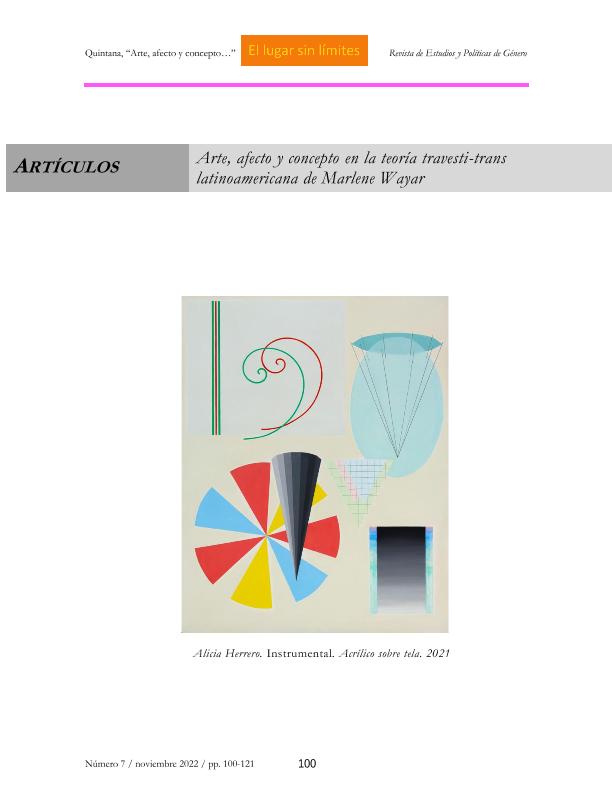Artículo
En este artículo abordo la teoría travesti de Marlene Wayar según tres vectores o potencias del pensamiento y la experiencia: el concepto, el arte y el afecto. Si bien a los fines de recorrer algunos tópicos los separo analíticamente, considero que es en la intersección de esas tres potencias que dicha teoría adquiere densidad epistemológica, ética y política. Así, busco mostrar que, en lo referido al concepto, la teoría travesti no solo desestabiliza la matriz cis heteropatriarcal, sino que, al reivindicar un “origen” precolombino de la travestidad, somete a crítica la colonialidad del género. En segundo lugar, en lo que concierne al afecto, me interesa analizar un repertorio de sentimientos que dan cuenta de cómo su distribución social desigual regula qué cuerpos (y de qué manera) pueden aparecer en el espacio público; pero también de cómo la teoría y la praxis travestis elaboran una respuesta afectiva-y-epistémica, cuyos motores son la indignación y la rabia. Por último, argumento que el arte, en tanto forma de revisión crítica de las actuaciones guionadas de los géneros hegemónicos, y como proyecto crítico de autoconstrucción corporal, es la dimensión que enlaza y ensambla las potencias conceptuales, perceptuales y afectivas de la teoría y la subjetividad travesti-trans latinoamericana. In this article, I address Marlene Wayar’s “travesti” theory according to three vectors of thought and experience: concept, art and affect. Although I separate them analytically in order to discuss some topics, I believe that it is at the intersection of these three vectors that the theory acquires epistemological, ethical and political density. Thus, I seek to show that regarding concept, not only does the “travesti” theory destabilize the cis-hetero-patriarchal matrix, but also, by revindicating a pre-Colombian “origin” of “travestidad”, it subjects the coloniality of gender to criticism. Secondly, regarding affect, I am interested in analyzing a repertoire of feelings concerning how its unequal social distribution regulates which bodies may appear in the public space (and how they may do so); but also, how “travesti” theory and praxis develop an affective-and-epistemic response, driven by indignation and anger. Finally, I argue that art, inasmuch as it is a form of critical review of the scripted performances of the hegemonic genders, and as a critical project of bodily selfconstruction, is the dimension that links and assembles the conceptual, perceptual and affective powers of Latin American “travesti-trans” theory and subjectivity
Arte, afecto y concepto en la teoría travesti-trans latinoamericana de Marlene Wayar
Título:
Art, affect and concept in the latin american transvestite-trans theory of Marlene Wayar
Fecha de publicación:
11/2022
Editorial:
Universidad Nacional de Tres de Febrero. Instituto de Investigaciones en Arte y Cultura “Dr. Norberto Griffa”. Centro Interdisciplinario de Estudios y Políticas de Género
Revista:
El lugar sin límites
ISSN:
2683-9105
Idioma:
Español
Tipo de recurso:
Artículo publicado
Clasificación temática:
Resumen
Archivos asociados
Licencia
Identificadores
Colecciones
Articulos(IIDYPCA)
Articulos de INST. DE INVESTIGACIONES EN DIVERSIDAD CULTURAL Y PROCESOS DE CAMBIO
Articulos de INST. DE INVESTIGACIONES EN DIVERSIDAD CULTURAL Y PROCESOS DE CAMBIO
Citación
Quintana, María Marta; Arte, afecto y concepto en la teoría travesti-trans latinoamericana de Marlene Wayar; Universidad Nacional de Tres de Febrero. Instituto de Investigaciones en Arte y Cultura “Dr. Norberto Griffa”. Centro Interdisciplinario de Estudios y Políticas de Género; El lugar sin límites; 4; 7; 11-2022; 100-121
Compartir




